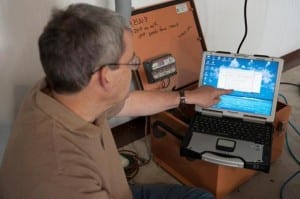SMU scientists stress that learning more about this recent series of earthquakes will be an incremental process
SMU’s seismology team will deploy 22 more seismographs in the Irving area over the next few days to better understand the series of earthquakes that United States Geological Survey (USGS) data indicates are occurring on or near the site of the old Texas Stadium.
Fifteen monitors are being deployed today, Jan. 7. Two more being provided by the USGS are expected to arrive and be deployed Thursday, and another five provided by Incorporated Research Institutions for Seismology (IRIS) are scheduled for deployment Friday.
The SMU scientists stress that learning more about this recent series of earthquakes will be an incremental process.

“In the near term, our first step is to put out seismographs to confirm and refine the location of the quakes and define the faults in the area,” said Heather DeShon, associate professor of geophysics at SMU. “Only after we get that data will we be in a position to investigate the potential cause of the earthquakes.”
The current earthquakes are the fourth sequence of felt earthquakes recorded in the Fort Worth Basin since 2008. The previous earthquakes sequences occurred near DFW Airport, Cleburne, and the Reno-Azle area. SMU studies of the DFW and Cleburne quakes cited wastewater injection wells as a plausible cause of the seismicity in those areas.
Information on those previous SMU studies is available at “Understanding recent North Texas seismicity.” The report on the earthquakes in the Azle-Reno area has not yet been released.
“It’s premature to speculate on the cause of this current series of seismic events,” said Brian Stump, SMU’s Albritton Chair of Geological Sciences. “We’re just getting started. We want to support the local community in understanding these earthquakes, and the team appreciates the cooperation of the City of Irving, the United States Geological Survey and IRIS in helping us get the best information possible.”
Follow SMUResearch.com on twitter at @smuresearch.
SMU is a nationally ranked private university in Dallas founded 100 years ago. Today, SMU enrolls nearly 11,000 students who benefit from the academic opportunities and international reach of seven degree-granting schools. For more information see www.smu.edu.
SMU has an uplink facility located on campus for live TV, radio, or online interviews. To speak with an SMU expert or book an SMU guest in the studio, call SMU News & Communications at 214-768-7650.




 Wall Street’s short sellers wrongly maligned — detected red flags ahead of US financial crisis
Wall Street’s short sellers wrongly maligned — detected red flags ahead of US financial crisis A director’s skills, experiences and workload drive their compensation, SMU study finds
A director’s skills, experiences and workload drive their compensation, SMU study finds Gut reaction of marital partners could foretell their marriage satisfaction
Gut reaction of marital partners could foretell their marriage satisfaction Fossil supervolcano discovered in Italy by SMU-led team is now key feature of new UNESCO Geopark
Fossil supervolcano discovered in Italy by SMU-led team is now key feature of new UNESCO Geopark NPR: “Boiling Hot: How Fracking’s Gusher of Geothermal Energy is Wasted”
NPR: “Boiling Hot: How Fracking’s Gusher of Geothermal Energy is Wasted” KERA, NOVA: SMU researcher Peter Weyand discusses the upper limits of human speed.
KERA, NOVA: SMU researcher Peter Weyand discusses the upper limits of human speed.
 The Undying Radio: Familiarity breeds content when it comes to listeners and music
The Undying Radio: Familiarity breeds content when it comes to listeners and music